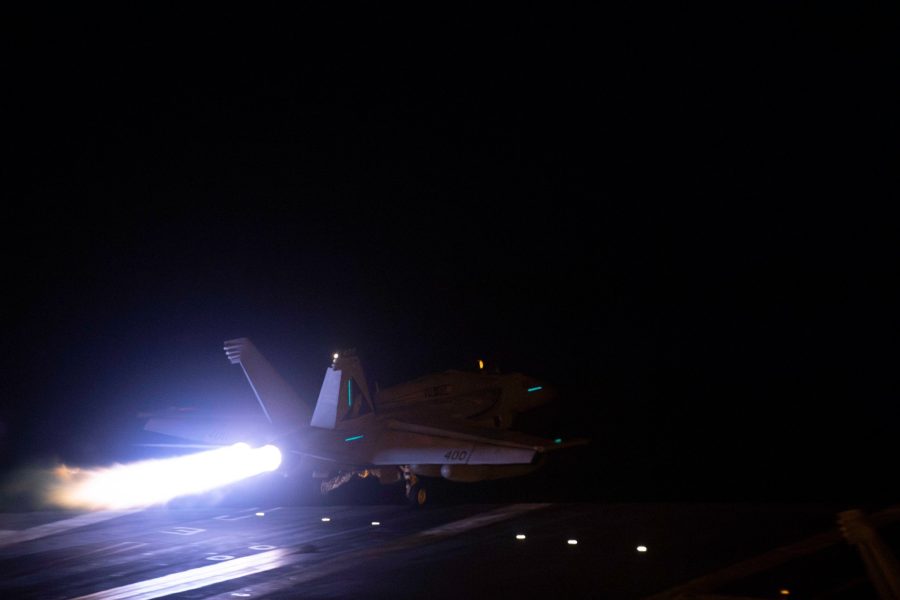American and British aircraft and warships carried out strikes against multiple targets in Houthi-controlled Yemen on Jan. 11, in response to continuing attacks on commercial shipping, U.S. and U.K. officials said.
The airstrikes and sea-launched cruise missiles were aimed at more than a dozen sites.
“Today’s strikes targeted sites associated with the Houthis’ unmanned aerial vehicle, ballistic and cruise missile, and coastal radar and air surveillance capabilities,” Secretary of Defense Lloyd J. Austin III said in a statement.
The strikes were carried out by U.S. Air Force, U.S. Navy, and U.K. Royal Air Force aircraft. Missiles were also launched from U.S. Navy surface and subsurface vessels, U.S. officials said.
The strikes were directed at over 60 targets at 16 locations, according to Air Forces Central commander Lt. Gen. Alexus G. Grynkewich. In a statement, Grynkewich added that over 100 precision-guided munitions of various types were used, including Tomahawk cruise missiles from the Navy. The Royal Air Force struck two targets with Paveway guided bombs from four Typhoons, the U.K. Ministry of Defense said in a statement.
U.S. and U.K. officials said “non-operational support” was provided by Australia, the Netherlands, Canada, and Bahrain.
Grynkewich said U.S. forces targeted “command and control nodes, munitions depots, launching systems, production facilities, and air defense radar systems,” while the U.K. said it targeted a drone launching site and an airfield.
The U.S. and 12 other countries issued a joint statement on Jan. 3 warning of “consequences” if attacks continued, which the U.S. officials indicated should be treated as a final warning to the rebel group.
On Jan. 9, the Iranian-backed group launched its largest salvo yet in what U.S. Central Command (CENTCOM) called a “complex attack” that involved two dozen drones and missiles. F/A-18s from the aircraft carrier USS Dwight D. Eisenhower and the guided-missile destroyers USS Gravely, USS Laboon, and USS Mason successfully defended against that attack, shooting down 18 attack drones, two anti-ship cruise missiles, and one anti-ship ballistic missile, according to CENTCOM.
The British Navy has also been involved, and the HMS Diamond shot down seven drones on Jan. 9, British Defense Secretary Grant Shapps said.
None of that, however, was enough to deter the Houthis. On Jan. 11, the Houthis launched their 27th attack on commercial shipping lanes in the Red Sea and surrounding waters since Nov. 19.
The U.S. and British strikes on Jan. 11 followed multiple calls between Chairman of the Joint Chiefs of Staff Air Force Gen. Charles Q. Brown Jr. and U.K. Chief of Defense Staff Adm. Sir Tony Radakin, and Shapps saying, “watch this space” on Jan. 10.
Houthi forces were already bracing for the attack before it took place and were vowing to retaliate.
“Any American attack will not remain without a response,” Houthi leader Abdul Malik al-Houthi said in a speech Jan. 11. “The response will be greater than the attack that was carried out with 20 drones and a number of missiles,” he added, referring to the Jan. 9 attack.
Iran, which has supplied weapons and provided intelligence to the Houthis, also anticipated the U.S. and British action. The Behshad, a suspected Iranian spy ship that has been parked in the Red Sea since 2021, left the Red Sea on Jan. 11 as Tehran braced for military action against its proxies, according to the ship-monitoring website Tanker Trackers.
Iranian forces, meanwhile, seized the oil tanker St. Nikolas on Jan. 11 while the vessel was transiting the international waters of the Gulf of Oman, according to the U.S. military.
Iran and the so-called Axis of Resistance of groups it has aligned with have launched attacks against U.S. forces and international shipping in the wake of the Israel-Hamas war.
In response to more than 130 attacks against U.S. troops in Iraq and Syria, the U.S. has conducted airstrikes against Iranian-aligned militia groups, including a rare targeted killing last week of a militia leader in Baghdad.
The U.S. and its allies have held off on striking back against the Houthis until now, instead launching the defensive Operation Prosperity Guardian maritime coalition. U.S. officials and regional security experts say the Houthis are more unpredictable and hardline than other Iranian-backed groups.
Vessels are at particular risk near Yemen because they must use Bab el-Mandeb strait to cross between the Red Sea and the Gulf of Aden, a critical chokepoint. According to the U.S. government, nearly 15 percent of seaborne trade passes through the Red Sea, which connects to the Mediterranean Sea via the Suez Canal. Many commercial shippers have been forced to divert ships around the southern coast of Africa, causing significant delays and costs for the global economy.
“I will not hesitate to direct further measures to protect our people and the free flow of international commerce as necessary,” President Joe Biden said in statement.

